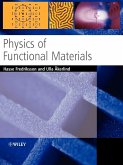This book surveys the physics of the quantum, finite many-body systems that are the basis of nanostructures such as fullerenes and metal clusters. The ab initio techniques for describing the single-particle motion (electrons) and the collective degrees of freedom (plasmons and phonons), and their interaction, are discussed in detail. Applications to the study of phenomena such as the electromagnetic response and superconductivity of these systems are considered. Built around current research and drawing upon lectures given to advanced undergraduates, the book will interest students, young researchers and practitioners in the fields of solid-state and atomic physics and physical chemistry.
Quantum mechanics is the set of laws of physics which, to the best of our knowledge, provides a complete account of the microworld. One of its chap ters, quantum electrodynamics (QED), is able to account for the quantal phenomena of relevance to daily life (electricity, light, liquids and solids, etc.) with great accuracy. The language of QED, field theory, has proved to be uni versal providing the theoretical basis to describe the behaviour of many-body systems. In particular finite many-body systems (FMBS) like atomic nuclei, metal clusters, fullerenes, atomic wires, etc. That is, systems made out of a small number of components. The properties of FMBS are expected to be quite different from those of bulk matter, being strongly conditioned by quantal size effects and by the dynamical properties of the surface of these systems. The study of the elec tronic and of the collective behaviour (plasmons and phonons) of FMBS and of their interweaving, making use of well established first principle quantum (field theoretical) techniques, is the main subject of the present monograph. The interest for the study of FMBS was clearly stated by Feynman in his address to the American Physical Society with the title "There is plenty of room at the bottom". On this occasion he said among other things: "When we get to the very, very small world - say circuits of seven atoms - we have a lot of new things that would happen that represent completely new opportunities for design" [1].
Quantum mechanics is the set of laws of physics which, to the best of our knowledge, provides a complete account of the microworld. One of its chap ters, quantum electrodynamics (QED), is able to account for the quantal phenomena of relevance to daily life (electricity, light, liquids and solids, etc.) with great accuracy. The language of QED, field theory, has proved to be uni versal providing the theoretical basis to describe the behaviour of many-body systems. In particular finite many-body systems (FMBS) like atomic nuclei, metal clusters, fullerenes, atomic wires, etc. That is, systems made out of a small number of components. The properties of FMBS are expected to be quite different from those of bulk matter, being strongly conditioned by quantal size effects and by the dynamical properties of the surface of these systems. The study of the elec tronic and of the collective behaviour (plasmons and phonons) of FMBS and of their interweaving, making use of well established first principle quantum (field theoretical) techniques, is the main subject of the present monograph. The interest for the study of FMBS was clearly stated by Feynman in his address to the American Physical Society with the title "There is plenty of room at the bottom". On this occasion he said among other things: "When we get to the very, very small world - say circuits of seven atoms - we have a lot of new things that would happen that represent completely new opportunities for design" [1].








